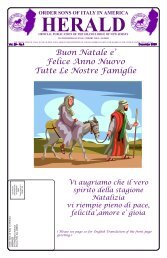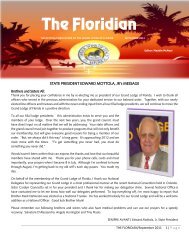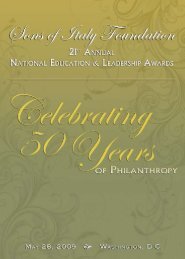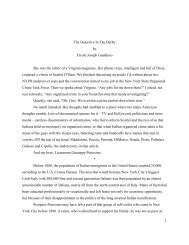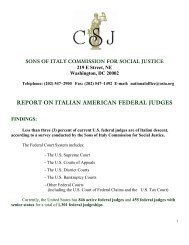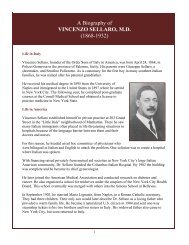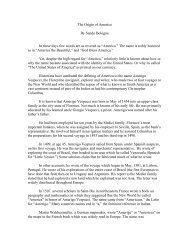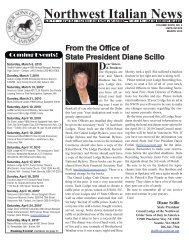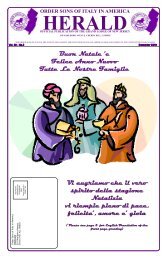Columbus: Fact vs. Fiction report - Order Sons of Italy in America
Columbus: Fact vs. Fiction report - Order Sons of Italy in America
Columbus: Fact vs. Fiction report - Order Sons of Italy in America
You also want an ePaper? Increase the reach of your titles
YUMPU automatically turns print PDFs into web optimized ePapers that Google loves.
COLUMBUS: FACT <strong>vs</strong>. FICTION<br />
Prepared by<br />
THE ORDER SONS OF ITALY<br />
IN AMERICA<br />
Contact:<br />
The <strong>Order</strong> <strong>Sons</strong> <strong>of</strong> <strong>Italy</strong> <strong>in</strong> <strong>America</strong><br />
219 E Street, N.E.<br />
Wash<strong>in</strong>gton, D.C. 20002<br />
Telephone: 202/547-2900<br />
Web site: www.osia.org
Introduction<br />
This study on Christopher <strong>Columbus</strong> was undertaken by the <strong>Order</strong> <strong>Sons</strong> <strong>of</strong> <strong>Italy</strong> <strong>in</strong> <strong>America</strong><br />
(OSIA) <strong>in</strong> response to grow<strong>in</strong>g concerns about the celebration <strong>of</strong> <strong>Columbus</strong> Day <strong>in</strong><br />
<strong>America</strong>. It was first released <strong>in</strong> 2002 and was updated <strong>in</strong> 2003.<br />
For much <strong>of</strong> its history, the United States considered <strong>Columbus</strong> a man worthy <strong>of</strong> admiration.<br />
<strong>Columbus</strong> Day is one <strong>of</strong> <strong>America</strong>’s oldest patriotic holidays, first celebrated <strong>in</strong> the 18 th century.<br />
<strong>America</strong> has more monuments to <strong>Columbus</strong> than any other nation <strong>in</strong> the world. Generations <strong>of</strong><br />
<strong>America</strong>n school children studied his life and accomplishments. Teachers held him up as an<br />
example <strong>of</strong> a person <strong>of</strong> character, who overcame strong opposition and great disappo<strong>in</strong>tment but<br />
never gave up try<strong>in</strong>g to prove what he believed to be true.<br />
S<strong>in</strong>ce 1992, however, the reputation <strong>of</strong> <strong>Columbus</strong> has suffered at the hands <strong>of</strong> special <strong>in</strong>terest<br />
groups who have used this Renaissance navigator <strong>of</strong> the 15 th century to further their 21 st century<br />
political and social agendas.<br />
As a result, today <strong>Columbus</strong> is <strong>of</strong>ten depicted as a slave trader, racist, and even “the Hitler <strong>of</strong> the<br />
15 th century.” A small but vocal number <strong>of</strong> historians, journalists, text-book writers and teachers<br />
have helped spread these charges despite their questionable foundations <strong>in</strong> historical fact.<br />
They have done so pr<strong>in</strong>cipally by assign<strong>in</strong>g to, evaluat<strong>in</strong>g, and judg<strong>in</strong>g a qu<strong>in</strong>tessentially<br />
Renaissance man and his actions by contemporary values and measurements. It bears not<strong>in</strong>g that<br />
England, birthplace <strong>of</strong> the Magna Carta, did not outlaw slavery <strong>in</strong> its colonies until 1833. The<br />
United States did not outlaw slavery until 1862 and Brazil, the late 1880s. In this context,<br />
<strong>Columbus</strong> was an enlightened and humane man.<br />
Italian <strong>America</strong>ns cont<strong>in</strong>ue to hold <strong>Columbus</strong> <strong>in</strong> high regard, however, not only for his historic<br />
achievements but also because <strong>Columbus</strong> Day is the only day our nation recognizes the heritage<br />
<strong>of</strong> an estimated 26 million <strong>America</strong>ns <strong>of</strong> Italian descent.<br />
Increas<strong>in</strong>gly, Italian <strong>America</strong>n communities are f<strong>in</strong>d<strong>in</strong>g their <strong>Columbus</strong> Day celebrations marred<br />
by demonstrations by special <strong>in</strong>terest groups who sometimes turn violent, as happened <strong>in</strong> Denver<br />
dur<strong>in</strong>g OSIA’s <strong>Columbus</strong> Day parade <strong>in</strong> 2000.<br />
OSIA presents this study on <strong>Columbus</strong> <strong>in</strong> an attempt to br<strong>in</strong>g more balance to the exam<strong>in</strong>ation <strong>of</strong><br />
this first important Renaissance explorer, his life, character and explorations.<br />
We thank <strong>Columbus</strong> scholars Robert Royal, Ph.D., president <strong>of</strong> the Faith and Reason Institute<br />
and David Curfman, M.D., president <strong>of</strong> the National <strong>Columbus</strong> Celebration Association <strong>in</strong><br />
Wash<strong>in</strong>gton, D.C., for shar<strong>in</strong>g their impressive knowledge <strong>of</strong> <strong>Columbus</strong> with us.<br />
Joseph Sciame<br />
OSIA National President<br />
Philip R. Piccigallo, Ph.D.<br />
OSIA Executive Director<br />
1
<strong>Columbus</strong>: <strong>Fact</strong> <strong>vs</strong>. <strong>Fiction</strong><br />
Prepared by<br />
THE ORDER SONS OF ITALY IN AMERICA<br />
Table <strong>of</strong> Contents<br />
<strong>Columbus</strong>: <strong>Fact</strong> <strong>vs</strong>. <strong>Fiction</strong>…………………………………page 3<br />
What <strong>Columbus</strong> Accomplished…………………………….page 8<br />
Why We Should Celebrate <strong>Columbus</strong> Day………………..page 9<br />
Christopher <strong>Columbus</strong>: Biography………………………..page 10<br />
Little-Known <strong>Fact</strong>s From Italian <strong>America</strong>n History……..page 11<br />
The <strong>Order</strong> <strong>Sons</strong> <strong>of</strong> <strong>Italy</strong> <strong>in</strong> <strong>America</strong>……………………….page 12<br />
Sources and Bibliography…………………………………..page 13<br />
2
<strong>Columbus</strong>: <strong>Fact</strong> <strong>vs</strong>. <strong>Fiction</strong><br />
FICTION: COLUMBUS DID NOT DISCOVER THE AMERICAS. THE VIKINGS DID.<br />
FACT:<br />
In 1950, a map surfaced <strong>in</strong> Europe that shows the “Island <strong>of</strong> V<strong>in</strong>land” <strong>in</strong> the northwest<br />
Atlantic Ocean. The map’s text <strong>in</strong> Medieval Lat<strong>in</strong> expla<strong>in</strong>s that Leif Erickson and his Vik<strong>in</strong>gs<br />
found V<strong>in</strong>land <strong>in</strong> the year 1000 A.D.<br />
The Smithsonian Institution <strong>in</strong> Wash<strong>in</strong>gton, D.C., dates the map’s parchment to around<br />
1434 A.D. – nearly 60 years before <strong>Columbus</strong>’s first voyage. But when researchers at London’s<br />
University College used a laser technique to test the map’s <strong>in</strong>k, they found it conta<strong>in</strong>ed a<br />
chemical substance called anatase, which was not synthesized until 1923, prov<strong>in</strong>g that the map is<br />
a forgery.<br />
Did <strong>Columbus</strong> “discover” <strong>America</strong> In every significant way, he did. Even if others<br />
visited the cont<strong>in</strong>ent sporadically before he did, their voyages had no historical significance.<br />
<strong>Columbus</strong>'s voyages, however, marked the end <strong>of</strong> thousands <strong>of</strong> years <strong>of</strong> isolation between the<br />
Western Hemisphere and the rest <strong>of</strong> the world. The recorded history <strong>of</strong> the <strong>America</strong>s and the<br />
Caribbean starts with <strong>Columbus</strong>.<br />
<strong>Columbus</strong>’s voyages contributed to the emergence <strong>of</strong> the modern world, <strong>in</strong> mak<strong>in</strong>g it<br />
possible for the first time <strong>in</strong> history for all people to be <strong>in</strong> contact with one another.<br />
FICTION: COLUMBUS FOUND SOPHISTICATED NATIVE CIVILIZATIONS.<br />
FACT: Most <strong>of</strong> the native tribes <strong>Columbus</strong> found were hunter-gatherers who engaged <strong>in</strong><br />
bloody tribal wars and, <strong>in</strong> the case <strong>of</strong> the Arawaks, Caribs and Canibs, slavery, torture and<br />
cannibalism.<br />
To survive, the native populations depended on “slash-and-burn” cultivation <strong>of</strong> the land<br />
along with hunt<strong>in</strong>g, fish<strong>in</strong>g and collect<strong>in</strong>g edible wild plants, seeds and shellfish. They had no<br />
written language, history or literature. In their struggle for survival, these peoples were not the<br />
environmental exemplars they are mistakenly portrayed today as hav<strong>in</strong>g been.<br />
3
FICTION: COLUMBUS WAS IN THE SLAVE TRADE.<br />
FACT: <strong>Columbus</strong> never owned any slaves or brought any to the Western Hemisphere from<br />
Africa. Follow<strong>in</strong>g his second voyage <strong>in</strong> 1493, however, <strong>Columbus</strong> and his men won a battle<br />
with some <strong>of</strong> the native tribes on the island <strong>of</strong> Hispaniola (now Haiti and the Dom<strong>in</strong>ican<br />
Republic). <strong>Columbus</strong> took 300 natives prisoners and sent them to Spa<strong>in</strong> to be held for ransom,<br />
as was the custom <strong>in</strong> the 15 th century with prisoners <strong>of</strong> war. The Spanish monarchs sent the<br />
natives back s<strong>in</strong>ce there was no chance they could ever be ransomed. <strong>Columbus</strong> never aga<strong>in</strong> sent<br />
prisoners <strong>of</strong> war to Spa<strong>in</strong>.<br />
<strong>Columbus</strong> found that slavery was practiced <strong>in</strong> the Caribbean by the native tribes. The<br />
Caribs and Canibs made slaves <strong>of</strong> the tribes they conquered and also ate their victims. (Hence<br />
the word “cannibal”).<br />
Later European explorers <strong>in</strong> Mexico and Central <strong>America</strong> found that even the more<br />
advanced civilizations <strong>of</strong> the Aztecs, Incas and Mayans kept slaves. They also practiced torture,<br />
ritual murder and the human sacrifice <strong>of</strong> their own women and children as well as <strong>of</strong> prisoners <strong>of</strong><br />
war. These practices horrified the Spanish and caused them to look down on native cultures. In<br />
fact, the Spanish arrival <strong>in</strong> the New World was the decisive factor that eventually ended the<br />
practices <strong>of</strong> human sacrifice and cannibalism.<br />
FICTION: COLUMBUS WAS A RACIST.<br />
FACT: No evidence <strong>in</strong>dicates that <strong>Columbus</strong> thought the islanders he met were racially<br />
<strong>in</strong>ferior <strong>in</strong> any way. In fact, <strong>in</strong> the journal <strong>of</strong> his first voyage, <strong>Columbus</strong> describes the Ta<strong>in</strong>os<br />
and other tribes as “well-made with f<strong>in</strong>e shapes and faces...their eyes were large and very<br />
beautiful...straight-limbed without exception and handsomely shaped....” He praises their<br />
generosity, <strong>in</strong>nocence and <strong>in</strong>telligence, say<strong>in</strong>g they could “readily become Christians as they<br />
have a good understand<strong>in</strong>g.”<br />
4
Initially, <strong>Columbus</strong> had friendly relations with the people he found <strong>in</strong> the West Indies.<br />
These relations soured after his second voyage when he found the colony <strong>of</strong> men he had left<br />
beh<strong>in</strong>d had been slaughtered and possibly eaten by the Caribs.<br />
FICTION: COLUMBUS COMMITTED GENOCIDE.<br />
FACT:<br />
The destruction <strong>of</strong> the native populations <strong>of</strong> the Western Hemisphere over the<br />
centuries is a complex historical tragedy. No one knows exactly how many people were here<br />
when the Europeans arrived. The numbers vary from 8 million to 145 million. Many<br />
researchers believe the number to be around 40 million.<br />
<strong>Columbus</strong> made four voyages to the Caribbean <strong>in</strong> a ten-year period (1492-1502),<br />
spend<strong>in</strong>g only a few months each time (except for the year he was shipwrecked on his fourth<br />
voyage.) It is <strong>in</strong>conceivable that he could have killed millions <strong>of</strong> people <strong>in</strong> so short a time.<br />
In fact, other than a few armed skirmishes neither <strong>Columbus</strong> nor his men had any violent<br />
episodes at all.<br />
Responsibility for the deaths <strong>of</strong> many thousands <strong>of</strong> natives can justly be attributed to the<br />
Spanish conquistadors and other Europeans who followed <strong>Columbus</strong> here. But even <strong>in</strong> this,<br />
s<strong>in</strong>ce there were more natives than Europeans, the loss <strong>of</strong> millions <strong>of</strong> lives could not have been<br />
caused by the Spaniards' warfare and forced labor alone.<br />
In fact, most <strong>of</strong> the native populations perished because they lacked immunity to such<br />
diseases as small pox, typhoid and diphtheria as well as the non-fatal childhood diseases <strong>of</strong><br />
measles and mumps that they caught from the Spanish explorers. These diseases were not<br />
transmitted deliberately and cannot be considered a tool <strong>of</strong> genocide. Scholars estimate that 80%<br />
<strong>of</strong> those who died were <strong>in</strong>fected without ever see<strong>in</strong>g a white man.<br />
Tragic as this epidemic was, it also bears remember<strong>in</strong>g that prior to the Europeans' arrival<br />
the Western Hemisphere was no Garden <strong>of</strong> Eden. The native populations gave the early<br />
explorers syphilis, which they brought back to Europe. New medical research on pre-Colombian<br />
mummies <strong>in</strong> Peru, Chile and remote areas far from the early European colonies reveals that<br />
5
tuberculosis, long thought European <strong>in</strong> orig<strong>in</strong>, was rampant among the Indian tribes before the<br />
arrival <strong>of</strong> <strong>Columbus</strong>.<br />
Arthritis, periodontal disease and significant bone erosion also afflicted the native<br />
populations well before the voyages <strong>of</strong> <strong>Columbus</strong> and other Europeans. Most adults, only <strong>in</strong><br />
their 20s and 30s, had terrible teeth or none at all. Very few lived past age 40.<br />
Clearly, blam<strong>in</strong>g <strong>Columbus</strong> for the exterm<strong>in</strong>ation <strong>of</strong> the native populations is as fair as<br />
blam<strong>in</strong>g the native populations for kill<strong>in</strong>g people who die from us<strong>in</strong>g tobacco and coca<strong>in</strong>e, which<br />
the natives <strong>in</strong>troduced to the Europeans.<br />
FICTION: COLUMBUS DESTROYED THE BALANCE BETWEEN MAN & NATURE.<br />
FACT:<br />
<strong>Columbus</strong> and the other Europeans brought with them Old World agricultural<br />
techniques, <strong>in</strong>clud<strong>in</strong>g crop rotation and animal breed<strong>in</strong>g. They also <strong>in</strong>troduced new tools<br />
(<strong>in</strong>clud<strong>in</strong>g the wheel) as well as new plants and domesticated animals, <strong>in</strong>clud<strong>in</strong>g the horse.<br />
These imports led to improved farm<strong>in</strong>g methods, a greater diversity <strong>of</strong> crops and a more<br />
dependable food supply that benefited the native populations. Perfected over the centuries, they<br />
have helped make the nations <strong>in</strong> the Western Hemisphere a significant source <strong>of</strong> food for the rest<br />
<strong>of</strong> the world.<br />
FICTION: COLUMBUS AND OTHER EUROPEANS STOLE THE NATIVES LAND.<br />
FACT: A sad fact <strong>of</strong> human civilization is that powerful nations usurp the land <strong>of</strong> the<br />
vanquished. The Spanish conquistadors who followed <strong>Columbus</strong> <strong>in</strong> the 16 th and 17 th centuries<br />
were establish<strong>in</strong>g an empire through military conquest. They did what Egypt, Persia, Rome and<br />
Ch<strong>in</strong>a did before them <strong>in</strong> Europe, the Middle East, and Asia. They also did what the Aztecs,<br />
Mayans, and Incas did <strong>in</strong> the <strong>America</strong>s. “The Iroquois Federation <strong>in</strong> North <strong>America</strong> subjugated<br />
so many Indians,” writes Richard Gamb<strong>in</strong>o, “that historian Francis Parkman calls them ‘the<br />
Romans <strong>of</strong> the New World’.”<br />
But <strong>Columbus</strong> himself had no part <strong>in</strong> this.<br />
It is worth po<strong>in</strong>t<strong>in</strong>g out that the Europeans brought some benefits to Lat<strong>in</strong> <strong>America</strong>.<br />
Their arrival gave the entire cont<strong>in</strong>ent a common language, while <strong>in</strong> North <strong>America</strong>, land taken<br />
6
from the Iroquois and other tribes eventually became the United States, a haven for the poor and<br />
oppressed from all over the world, who f<strong>in</strong>d opportunities and freedoms here that their own<br />
countries deny them.<br />
The arrival <strong>of</strong> <strong>Columbus</strong> <strong>in</strong> the Western Hemisphere more than 500 years ago enriched<br />
Western civilization <strong>in</strong> ways that are still measurable.<br />
[For sources, see page 11.]<br />
7
What <strong>Columbus</strong> Accomplished<br />
HISTORICAL:<br />
• <strong>Columbus</strong> proved that it was possible to cross the Atlantic Ocean and back.<br />
• <strong>Columbus</strong> founded the first permanent European settlement <strong>in</strong> the Western Hemisphere,<br />
Hispaniola (now Haiti and the Dom<strong>in</strong>ican Republic).<br />
• <strong>Columbus</strong> was the first to open relations between Europe and the Western Hemisphere. His<br />
voyages mark the beg<strong>in</strong>n<strong>in</strong>g <strong>of</strong> more than 500 years <strong>of</strong> cultural, economic and political<br />
relations between Europe and the <strong>America</strong>s.<br />
• The recorded history <strong>of</strong> the Western Hemisphere beg<strong>in</strong>s with <strong>Columbus</strong>. There was no<br />
written history about these vast cont<strong>in</strong>ents before his arrival <strong>in</strong> 1492.<br />
NAVIGATIONAL:<br />
• <strong>Columbus</strong> was the first European to realize the full importance <strong>of</strong> the Atlantic w<strong>in</strong>d pattern<br />
called the prevail<strong>in</strong>g Westerlies, which blew steadily west to east. This conv<strong>in</strong>ced him it was<br />
possible to sail west with the Trade W<strong>in</strong>ds to the New World and return to Europe with the<br />
Westerlies.<br />
• Dur<strong>in</strong>g his four transatlantic voyages, <strong>Columbus</strong> chartered the route for what today are the<br />
islands <strong>of</strong> Cuba, Haiti, the Dom<strong>in</strong>ican Republic, Puerto Rico, Jamaica, the Lesser Antilles<br />
and the coasts <strong>of</strong> Panama, Honduras and Venezuela.<br />
• <strong>Columbus</strong>’s trans-Atlantic route lay the foundation for future navigation <strong>in</strong> the region. His<br />
maps were used by Amerigo Vespucci (after whom the <strong>America</strong>n cont<strong>in</strong>ent takes its name),<br />
whose maps were used by later explorers <strong>of</strong> South <strong>America</strong>. <strong>Columbus</strong>’s maps also helped<br />
Magellan follow the coasts <strong>of</strong> South <strong>America</strong> dur<strong>in</strong>g his voyage around the world.<br />
• The route across the Atlantic Ocean that <strong>Columbus</strong> charted <strong>in</strong> the 15 th century is still used by<br />
sailors today.<br />
• <strong>Columbus</strong> <strong>in</strong>troduced the pr<strong>in</strong>ciple <strong>of</strong> compass variation (the variation at any po<strong>in</strong>t on the<br />
Earth’s surface between the direction to magnetic and geographic north) and observed the<br />
rotation <strong>of</strong> the Pole star.<br />
8
Why We Should Celebrate <strong>Columbus</strong> Day<br />
• <strong>Columbus</strong> Day recognizes the achievements <strong>of</strong> a great Renaissance explorer who founded the<br />
first permanent European settlement <strong>in</strong> the New World. The arrival <strong>of</strong> <strong>Columbus</strong> <strong>in</strong> 1492<br />
marks the beg<strong>in</strong>n<strong>in</strong>g <strong>of</strong> recorded history <strong>in</strong> <strong>America</strong> and opened relations between the<br />
<strong>America</strong>s and the rest <strong>of</strong> the world.<br />
• <strong>Columbus</strong> Day celebrates the beg<strong>in</strong>n<strong>in</strong>g <strong>of</strong> cultural exchange between <strong>America</strong> and Europe.<br />
After <strong>Columbus</strong>, millions <strong>of</strong> European immigrants brought their art, music, science,<br />
medic<strong>in</strong>e, philosophy and religious pr<strong>in</strong>ciples to <strong>America</strong>. These contributions have helped<br />
shape the United States and <strong>in</strong>clude Greek democracy, Roman law, Judeo-Christian ethics<br />
and the belief that all men are created equal.<br />
• <strong>Columbus</strong> Day is one <strong>of</strong> <strong>America</strong>’s oldest holidays. The tradition <strong>of</strong> observ<strong>in</strong>g <strong>Columbus</strong><br />
Day dates back to the 18 th century. It was first celebrated on October 12, 1792, when the<br />
New York Society <strong>of</strong> Tammany honored <strong>Columbus</strong> on the 300 th anniversary <strong>of</strong> his first<br />
voyage.<br />
• <strong>Columbus</strong> Day is a patriotic holiday. In fact, the Pledge <strong>of</strong> Allegiance was written <strong>in</strong> 1892 <strong>in</strong><br />
honor <strong>of</strong> the 400 th anniversary <strong>of</strong> his first voyage. That year, President Benjam<strong>in</strong> Harrison<br />
declared <strong>Columbus</strong> Day a legal holiday.<br />
• The United States has long admired <strong>Columbus</strong>. <strong>America</strong> has more monuments to <strong>Columbus</strong><br />
than any nation <strong>in</strong> the world, accord<strong>in</strong>g to the Christopher <strong>Columbus</strong> Encyclopedia. These<br />
<strong>in</strong>clude a <strong>Columbus</strong> statue <strong>in</strong> Providence, R.I., cast by Frederic Auguste Bertholdi, who<br />
created the Statue <strong>of</strong> Liberty, and one <strong>in</strong> New York City, created by one <strong>of</strong> the six Italian<br />
<strong>America</strong>n brothers who carved the L<strong>in</strong>coln Memorial.<br />
• The United States has a significant collection <strong>of</strong> <strong>Columbus</strong> memorabilia, <strong>in</strong>clud<strong>in</strong>g his desk,<br />
papers, and the cross he used to claim the New World for Spa<strong>in</strong>. These are <strong>in</strong> the <strong>Columbus</strong><br />
Chapel <strong>in</strong> Boalsburg, Pennsylvania.<br />
• In 1971, <strong>Columbus</strong> Day became a federal holiday <strong>in</strong> all 50 states after Congress passed a law<br />
declar<strong>in</strong>g the second Monday <strong>in</strong> October <strong>Columbus</strong> Day.<br />
• <strong>Columbus</strong> Day also commemorates the arrival on these shores <strong>of</strong> more than 5 million Italians<br />
a century ago. Today, their children and grandchildren constitute the nation’s fifth largest<br />
ethnic group, accord<strong>in</strong>g to the U.S. Census Bureau.<br />
• <strong>Columbus</strong> Day is the only day on which the nation recognizes the heritage <strong>of</strong> an estimated 26<br />
million Italian <strong>America</strong>ns.<br />
9
Christopher <strong>Columbus</strong>: Biography<br />
1451 Christopher <strong>Columbus</strong> (Crist<strong>of</strong>oro Colombo) is born <strong>in</strong> Genoa to Domenico Colombo<br />
and his wife, Susanna Fontanarossa. They were weavers who lived above their small<br />
shop. At that time, Genoa was a naval power and <strong>in</strong>dependent republic that rivaled<br />
Venice and traded with the Orient. In 1453, two years after <strong>Columbus</strong>’s birth,<br />
Constant<strong>in</strong>ople fell to the Moslems, cutt<strong>in</strong>g <strong>of</strong>f Europe’s eastward trade routes to the<br />
Orient and mak<strong>in</strong>g the f<strong>in</strong>d<strong>in</strong>g <strong>of</strong> a westward route imperative.<br />
1465 <strong>Columbus</strong> takes his first sea voyage at age 14. Later he studies navigation <strong>in</strong> Greece and<br />
mapmak<strong>in</strong>g <strong>in</strong> Portugal, where he lives for n<strong>in</strong>e years <strong>in</strong> a colony <strong>of</strong> Genoese<br />
bus<strong>in</strong>essmen and shippers. He also travels to Africa, Ireland, England and Iceland.<br />
1479 <strong>Columbus</strong> marries Felipa Perestrello y Moniz (1479), has a son, Diego, and is widowed<br />
(1480). [Later, he has another son, Fernando, with Beatrice de Harana, whom he never<br />
marries.]<br />
1481 <strong>Columbus</strong> presents his plan to reach the Orient by sail<strong>in</strong>g west across the Atlantic to the<br />
k<strong>in</strong>gs <strong>of</strong> Portugal, England, France and Spa<strong>in</strong>. Only Spa<strong>in</strong>’s K<strong>in</strong>g Ferd<strong>in</strong>and and Queen<br />
Isabella accept his <strong>of</strong>fer, but it takes <strong>Columbus</strong> six years (1486-1492) to conv<strong>in</strong>ce them to<br />
underwrite his explorations.<br />
1492 On August 3, <strong>Columbus</strong> sails from Palos, Spa<strong>in</strong>. On October 12 at two o’clock <strong>in</strong> the<br />
morn<strong>in</strong>g, land is sighted. It was an island which he names San Salvador (Holy Savior).<br />
Deeply religious, <strong>Columbus</strong> believes one <strong>of</strong> his missions is to br<strong>in</strong>g Christianity to the<br />
New World.<br />
1502 <strong>Columbus</strong> makes his last voyage across the ocean. He crossed the Atlantic four times <strong>in</strong><br />
10 years: 1492, 1493, 1498 and 1502.<br />
On his first voyage he lands on Haiti and the Dom<strong>in</strong>ican Republic, which he calls<br />
“Hispaniola,” where he founds the first permanent European settlement <strong>in</strong> the Western<br />
Hemisphere. On his third voyage, his political enemies br<strong>in</strong>g him back to Spa<strong>in</strong> <strong>in</strong><br />
cha<strong>in</strong>s, but the Queen absolves him <strong>of</strong> any blame. On his fourth voyage, he was<br />
shipwrecked for nearly a year on what is today Jamaica.<br />
1506 <strong>Columbus</strong> dies <strong>in</strong> Valladolid, Spa<strong>in</strong>, on May 20 at age 54. He <strong>in</strong>sists on be<strong>in</strong>g buried with<br />
the cha<strong>in</strong>s he wore when he was brought back to Spa<strong>in</strong>, follow<strong>in</strong>g his third voyage. No<br />
one is sure where he is buried. Some scholars believe his rema<strong>in</strong>s are <strong>in</strong> the Cathedral <strong>of</strong><br />
Santo Dom<strong>in</strong>go <strong>in</strong> the Dom<strong>in</strong>ican Republic while others believe they are <strong>in</strong> Spa<strong>in</strong> <strong>in</strong> the<br />
Cathedral <strong>of</strong> Seville.<br />
10
Little-Known <strong>Fact</strong>s From Italian <strong>America</strong>n History*<br />
For more <strong>in</strong>formation about Italian <strong>America</strong>n issues, history, and culture,<br />
Visit the <strong>Sons</strong> <strong>of</strong> <strong>Italy</strong> web site at www.osia.org<br />
• John Cabot [1450 c. - 1498], born Giovanni Caboto, discovered North <strong>America</strong> <strong>in</strong> 1497.<br />
Cabot sailed for the British. His voyage led to the English colonization <strong>of</strong> <strong>America</strong>. His son,<br />
Sebastian Cabot [1482-1557] explored South <strong>America</strong> for Spa<strong>in</strong>.<br />
• Two signers <strong>of</strong> the Declaration <strong>of</strong> Independence were <strong>of</strong> Italian descent: Maryland’s William<br />
Paca and Delaware’s Caesar Rodney.<br />
• Five to ten thousand Italians fought <strong>in</strong> the Civil War for both the Union and the Confederacy.<br />
Three were Union generals. One Union <strong>of</strong>ficer, Col. Luigi Palma di Cesnola received one<br />
<strong>of</strong> the first Medals <strong>of</strong> Honor. He later became the first director <strong>of</strong> New York’s Metropolitan<br />
Museum <strong>of</strong> Art.<br />
• Italian immigrant Attilio Piccirilli and his five brothers carved the L<strong>in</strong>coln Memorial <strong>in</strong><br />
Wash<strong>in</strong>gton, D.C. They also carved the lions on the steps <strong>of</strong> the New York Public Library<br />
and the facade <strong>of</strong> the Brooklyn Museum among many other works.<br />
• In 1978, at age 38, A. Bartlett Giamatti (1940-1989) became the youngest president <strong>of</strong> Yale<br />
University <strong>in</strong> 200 years and the first president not <strong>of</strong> Anglo Saxon heritage. He served until<br />
1986, leav<strong>in</strong>g to become president and later commissioner <strong>of</strong> major league baseball’s<br />
National League.<br />
• Ed McBa<strong>in</strong> (b. 1926), <strong>in</strong>ventor <strong>of</strong> the police novel, has written 94 novels with 100 million<br />
copies <strong>in</strong> many languages. He was born Salvatore Albert Lomb<strong>in</strong>o but an editor told him<br />
his Italian name might hurt sales.<br />
• The only enlisted Mar<strong>in</strong>e <strong>in</strong> World War II who earned the nation’s two highest military<br />
honors, the Navy Cross and the Medal <strong>of</strong> Honor, was John Basilone, a U.S. Mar<strong>in</strong>e sergeant,<br />
who died at the Battle <strong>of</strong> Iwo Jima <strong>in</strong> World War II. He received the U.S. Medal <strong>of</strong> Honor <strong>in</strong><br />
1942 and was posthumously awarded the Navy Cross for heroism at Iwo Jima dur<strong>in</strong>g<br />
February 1945.<br />
• Robert Gallo, M.D., a research scientist and virologist, co-discovered the AIDS virus <strong>in</strong><br />
1984 and developed a blood test to screen for the disease. In 1978, he discovered and<br />
isolated the virus that is l<strong>in</strong>ked to leukemia.<br />
• The suburban shopp<strong>in</strong>g mall was developed by William Cafaro and Edward J. DeBartolo.<br />
Cafaro pioneered the enclosed shopp<strong>in</strong>g mall with his <strong>America</strong>n Mall <strong>in</strong> Lima, Ohio, <strong>in</strong><br />
1965. DeBartolo built the first <strong>America</strong>n shopp<strong>in</strong>g plaza <strong>in</strong> the 1940s.<br />
• Susan Sarandon, Bruce Spr<strong>in</strong>gsteen and Georgia O’Keeffe are <strong>of</strong> Italian descent.<br />
* Source: The National Italian <strong>America</strong>n Foundation<br />
11
The <strong>Order</strong> <strong>Sons</strong> <strong>of</strong> <strong>Italy</strong> <strong>in</strong> <strong>America</strong><br />
National Headquarters<br />
219 E Street, NE<br />
Wash<strong>in</strong>gton, DC 20002<br />
Tel: 202 547 2900<br />
Web: www.osia.org<br />
• The <strong>Order</strong> <strong>Sons</strong> <strong>of</strong> <strong>Italy</strong> <strong>in</strong> <strong>America</strong> (OSIA) is the largest and oldest<br />
national organization <strong>in</strong> the United States for Italian <strong>America</strong>n men<br />
and women.<br />
• Founded <strong>in</strong> 1905 <strong>in</strong> New York City’s Little <strong>Italy</strong>, OSIA has grown to<br />
600,000 members <strong>in</strong> all 50 states and two U.S. territories. It <strong>in</strong>cludes<br />
a network <strong>of</strong> more than 700 chapters <strong>in</strong> 35 states and the District <strong>of</strong><br />
Columbia.<br />
• Its mission <strong>in</strong>cludes encourag<strong>in</strong>g the study <strong>of</strong> Italian language and<br />
culture <strong>in</strong> <strong>America</strong>n schools and universities; preserv<strong>in</strong>g Italian<br />
<strong>America</strong>n traditions, culture, history and heritage; and promot<strong>in</strong>g<br />
closer cultural relations between the United States and <strong>Italy</strong>.<br />
• The <strong>Sons</strong> <strong>of</strong> <strong>Italy</strong> Foundation (SIF) is a private, grant-mak<strong>in</strong>g<br />
philanthropic <strong>in</strong>stitution established by OSIA <strong>in</strong> 1959. To date, the<br />
SIF has given more than $83 million to scholarships, medical<br />
research, cultural preservation, disaster relief and other projects.<br />
• The Commission for Social Justice (CSJ) is the anti-defamation arm<br />
<strong>of</strong> OSIA. The CSJ is committed to fight<strong>in</strong>g racism, prejudice, and the<br />
stereotyp<strong>in</strong>g <strong>of</strong> all races, religions and cultures.<br />
12
<strong>Columbus</strong>: <strong>Fact</strong> <strong>vs</strong>. <strong>Fiction</strong><br />
Sources & Bibliography<br />
• D’Souza, D<strong>in</strong>esh, “The Crimes <strong>of</strong> <strong>Columbus</strong>," First Th<strong>in</strong>gs 57, 1995.<br />
• Gamb<strong>in</strong>o, Richard, “The Question <strong>of</strong> <strong>Columbus</strong>’s Historical Significance,”<br />
Italian Journal, Vol. VI, No. 4, 1992.<br />
• Gamb<strong>in</strong>o, Richard, “Revisions <strong>of</strong> the Myth,” <strong>Columbus</strong>: Meet<strong>in</strong>g <strong>of</strong><br />
Cultures, 1992.<br />
• Hart, Jeffrey, “Discover<strong>in</strong>g <strong>Columbus</strong>,” National Review, Oct. 15, 1990.<br />
• Henige, David, Numbers From Nowhere, University <strong>of</strong> Oklahoma, 1998.<br />
• Medieval Source Book: Christopher <strong>Columbus</strong>: Extracts from His Journal.<br />
• Meyer, Karl, “<strong>Columbus</strong> Was Not Eichmann,” NY Times, June 27, 1991.<br />
• Mullen, William, “Mummies’ Secret: Ills not all <strong>Columbus</strong>’s Fault,”<br />
Chicago Tribune, Nov. 29, 2001.<br />
• Picker<strong>in</strong>g, Keith A., <strong>Columbus</strong> & the Destruction <strong>of</strong> Native Peoples. (Web)<br />
• Royal, Robert, 1492 And All That: Political Manipulations <strong>of</strong> History (1992).<br />
• Taviani, Emilio, Crist<strong>of</strong>oro Colombo: Genius <strong>of</strong> the Sea, 1990.<br />
• “V<strong>in</strong>land Map Is a Fake – Maybe,” Wash<strong>in</strong>gton Post, Aug. 5, 2002.<br />
13




